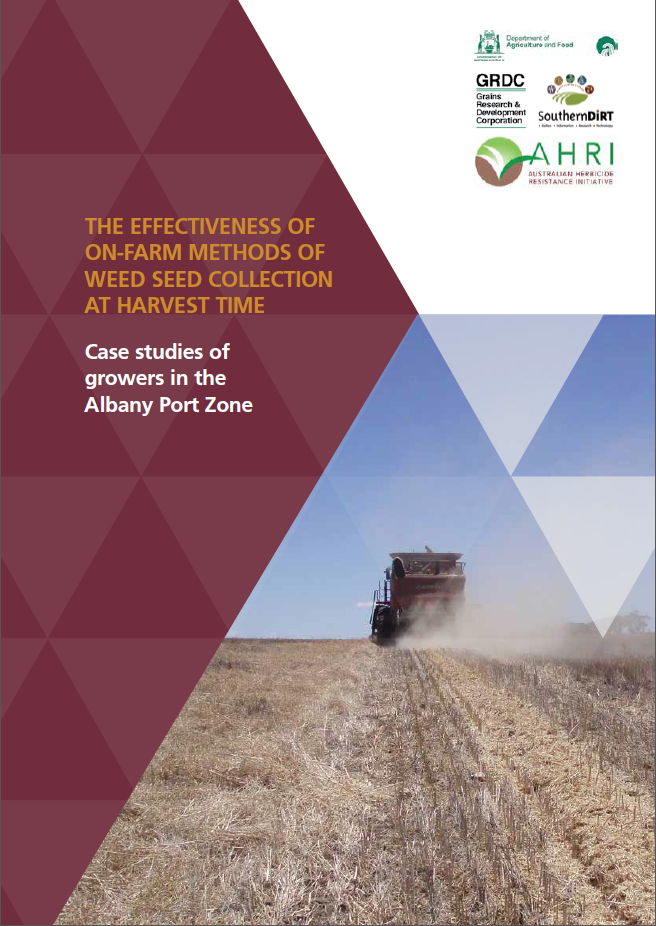The effectiveness of on-farm methods of weed seed collection at harvest time: Case studies of growers in the Albany Port Zone
Summary
The practical implications of harvest weed seed control are a more resilient farming system with some insurance against further resistance evolution.
The combination of effective herbicide use, plus harvest weed seed control techniques has been shown to reduce and maintain weed populations at very low densities.
In cropping systems, low weed densities, regardless of their herbicide resistance status, allows flexibility in crop choice, seeding time and herbicide use.
This flexibility provides growers with the capacity to readily adjust farming practices in tune with seasonal and market considerations.
Purpose of the case studies
In Western Australia, where high frequencies of herbicide resistant annual weed populations have been driving farming practices for the last decade, techniques targeting weed seeds during harvest have been widely adopted. The collection and management of the weed seed bearing chaff fraction at harvest time results in significant reductions in annual weed population densities.
Harvest weed seed control provides the opportunity to more effectively manage weed populations and allows the grower to move away from the almost complete reliance on herbicides for weed control. The consequence of this is that growers then have more flexibility in the overall management of their cropping program.
Harvest weed seed control tools – where do they fit?
- Narrow windrow burning is best suited to low to medium rainfall zones to facilitate burning of the windrow without burning the whole paddock and to minimise nutrient removal in residues.
- Chaff carts can be used everywhere. They are a cost effective, practical tool that suits all rainfall zones, but they do still involve burning of some crop residue in most situations.
- Bale Direct is best suited to where a reliable market for straw exists close by.
- Harrington Seed Destructor (HSD) is best suited to larger areas of crop in medium to high rainfall zones.
Recent on-farm research
Case studies have been conducted in the past by various groups including AHRI, and DAFWA. These case studies are excellent and in many cases have been incorporated into extension material. However, many of these case studies have been conducted either in the north or central wheatbelt of WA.
The case studies here focus on areas in the Albany Port Zone that have in the past not had an extensive exposure to weed seed control methods.
Most will have heard about the Harrington Seed Destructor which has been proven to be an excellent tool for weed seed collection and destruction.
However, many in the Zone have expressed interest in finding a ‘Poor Man’s’ Seed Destructor’ version. It is possible that growers within the Zone have engineered something that may be as effective – but cheaper to install and make. Other innovative growers may have adopted other methods of weed seed collection and/ or destruction. These case studies will look at different options that growers have adopted to control weed seed set in problem weeds in the Albany Zone.
Growers in the southern parts of WA often experience out of season rainfall during summer which those in the northern wheatbelt do not. Many of the areas where previous case studies have been undertaken do not experience the same degree of summer rainfall. How have the growers in the southern region adapted to these altered conditions?
Case studies examine positive and negative aspects of managing weed seeds at harvest from the grower perspective.
The key to successful harvest weed seed management relies on timing of the method chosen in relation to weed seed maturity, seed shedding and harvest time. These case studies seek to not only discuss benefits and practicalities of individual growers weed management tactics; they also aim to assist others to decide if adopting similar methods would be beneficial on their property.
These case studies present options. Obviously there are no right or wrong options, just different ones, and the more thought-provoking the better. Collectively, these case studies demonstrate that there is a multitude of choices to suit every situation.
Want to link to this publication?
Use www.grdc.com.au/CaseStudy-WeedSeedHarvest-Albany to ensure your link remains current and up-to-date!
A limited number of hard copies of this booklet are available and can be accessed by contacting:
Julianne Hill, regionalcroppingsolutions@gmail.com, (08) 9726 1307.
Alternately, you can download a PDF of this booklet from the download box on this page.
Was this page helpful?
YOUR FEEDBACK

